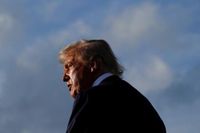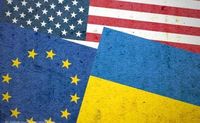In a week marked by tragedy and high-stakes diplomacy, U.S. and European officials have intensified their efforts to curb Russia’s war machine through a new wave of sanctions and economic measures, following the largest aerial assault on Ukraine since the conflict began over three and a half years ago. The renewed push comes as President Donald Trump and his administration grapple with the challenge of compelling Russian President Vladimir Putin to the negotiating table, while the European Union works to finalize its 19th package of sanctions targeting Moscow’s vital oil revenues.
On Monday evening, September 8, 2025, a high-level meeting convened at the U.S. Treasury Department in Washington, D.C. brought together officials from both sides of the Atlantic. According to the Associated Press, the session—lasting less than two hours—included U.S. Treasury Secretary Scott Bessent, representatives from the White House, State Department, and U.S. Trade Representative, as well as European experts focused on energy, sanctions policy, financial services, and trade. The agenda was packed: new sanctions, tariffs on Russian oil, and the fate of billions in Russian sovereign assets immobilized in Europe were all up for discussion.
“We are willing to take strong measures against Russia, but our European partners must fully join us in this to be successful. I made this clear today when meeting with EU Commission Sanctions Envoy David O’Sullivan,” Bessent told reporters, as quoted by RBC Ukraine. The meeting underscored the need for collective action, with both sides recognizing that unilateral steps would be less effective than a united front. Consultations were set to continue the following day, with officials determined to hammer out a coordinated strategy.
This diplomatic flurry was triggered by Russia’s record-breaking weekend assault on Ukraine. As reported by Reuters and Global Images Ukraine, Moscow fired over 800 drones and missiles across the country, targeting more than 30 locations and inflicting severe damage in Kyiv. The attack killed four people, wounded more than 40 others, and, for the first time, struck Ukraine’s central government headquarters, causing a “huge” fire and blowing a gaping hole in the upper floors of the building—a grim escalation that shocked the international community.
Ukrainian President Volodymyr Zelenskyy, speaking to ABC News, didn’t mince words: “I’m very thankful to all the partners, but some of them, I mean, they continue [to] buy oil and Russian gas, and this is not fair. I think, what I think, I think the idea to put tariffs on the countries who continue [to] make deals with Russia. I think this is [the] right idea.” Zelenskyy’s remarks highlight a persistent frustration in Kyiv: while Western nations have imposed sweeping sanctions, loopholes remain as some countries continue to purchase Russian energy, fueling the Kremlin’s war effort.
In response, the Trump administration has ramped up pressure not only on Russia but also on those who do business with it. According to NBC News, the U.S. has already imposed 50% tariffs on India—one of the highest rates ever levied—over its continued purchases of Russian oil. Treasury Secretary Bessent articulated the stakes in stark terms: “We are in a race now between how long can the Ukrainian military hold up versus how long can the Russian economy hold up. And if the U.S. and the EU can come in, do more sanctions, secondary tariffs on the countries that buy Russian oil, the Russian economy will be in total collapse, and that will bring President Putin to the table.”
Yet, as The Associated Press reported, the Kremlin remains defiant. On Monday, a Russian spokesperson declared that no sanctions would ever force Moscow to change course on its invasion of Ukraine. President Putin himself has insisted that Western economic pressure will not alter his goals, a stance that has frustrated Western policymakers and complicated diplomatic efforts.
Behind the scenes, the European Union is moving forward with its 19th package of sanctions, with a particular focus on crippling Russian oil sales—a key source of revenue for the Kremlin. European Commissioner for Energy Dan Jorgensen has been unequivocal, stating that the EU should completely abandon Russian energy imports and not resume supplies even after the war ends. Washington, for its part, shares this position, with both sides advocating a full cessation of Russian oil and gas imports.
The coordination between Brussels and Washington is closer than ever. EU Council President Antonio Costa expressed hope that the U.S. and Europe could “create a united front against Putin,” especially after earlier attempts at coordination faltered when Trump pursued his own peace talks with Russia. This time, the stakes are higher, and the urgency is palpable.
Amid these developments, the political context is anything but simple. President Trump has faced criticism for his earlier reluctance to join G7 allies in lowering the price cap on Russian crude oil, which was set at $47.60 a barrel before sanctions were imposed. Nevertheless, Trump has recently signaled a willingness to take significant actions if Europe stands firmly with him. “I believe we’re going to get it settled,” Trump told reporters on Sunday, September 7, 2025. “I have confidence we’re going to get it done.”
Trump’s diplomatic efforts have included direct outreach to both Putin and Zelenskyy. He hosted a summit with Putin last month in Alaska and has been pushing for direct talks between the Russian and Ukrainian presidents—a move he hopes could finally end the war. However, a Trump-imposed deadline for the Kremlin to end its invasion, set in August, came and went without resolution. “I expected this to be easier,” Trump admitted, acknowledging that the conflict has proved far more intractable than anticipated.
European officials, meanwhile, are not resting on their laurels. As Scott Lucas discussed on Poland’s TVP World, Europe’s maneuvers with the Trump administration are shaped by Russia’s relentless assault on Ukrainian civilians and the broader threat posed by Moscow, including to strategic areas like the Suwalki Gap between Lithuania and Poland. The upcoming Ramstein Group talks on military support for Kyiv—and the ongoing escalation in defense production by Europe and Ukraine—underscore the multifaceted nature of the West’s response.
As the world watches, the outcome of these talks and the effectiveness of new sanctions will shape the next chapter of the war. For now, the people of Ukraine continue to endure unimaginable hardship, while Western leaders weigh the risks and rewards of economic warfare in their bid to force a breakthrough at the negotiating table.
Whatever comes next, it’s clear that unity and resolve among allies will be crucial if they hope to change the calculus in Moscow and bring an end to Europe’s bloodiest conflict in a generation.


